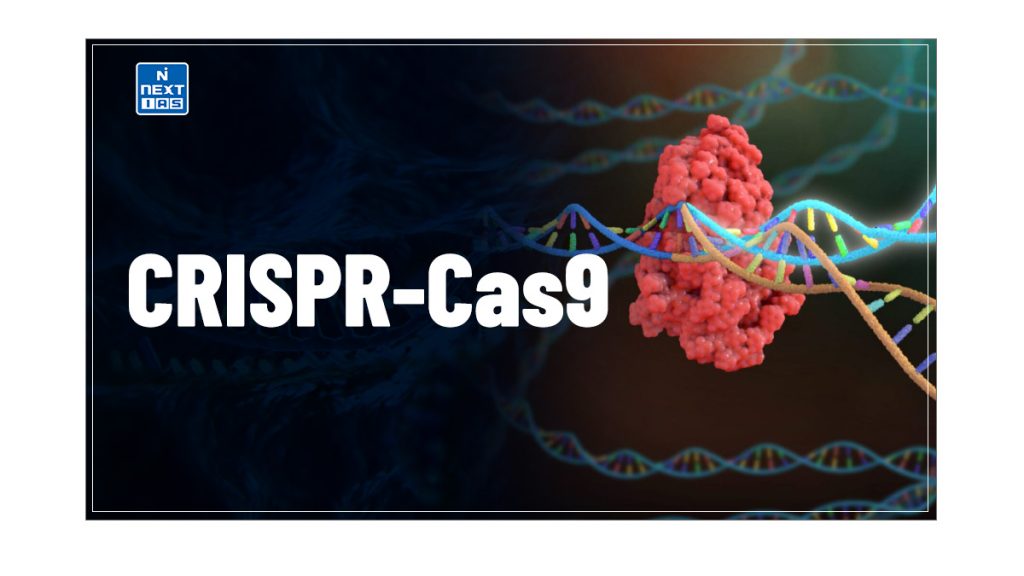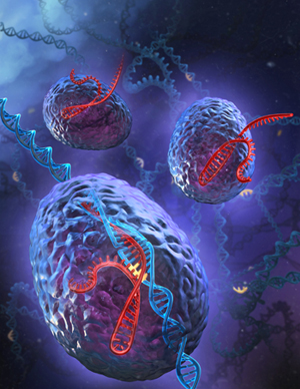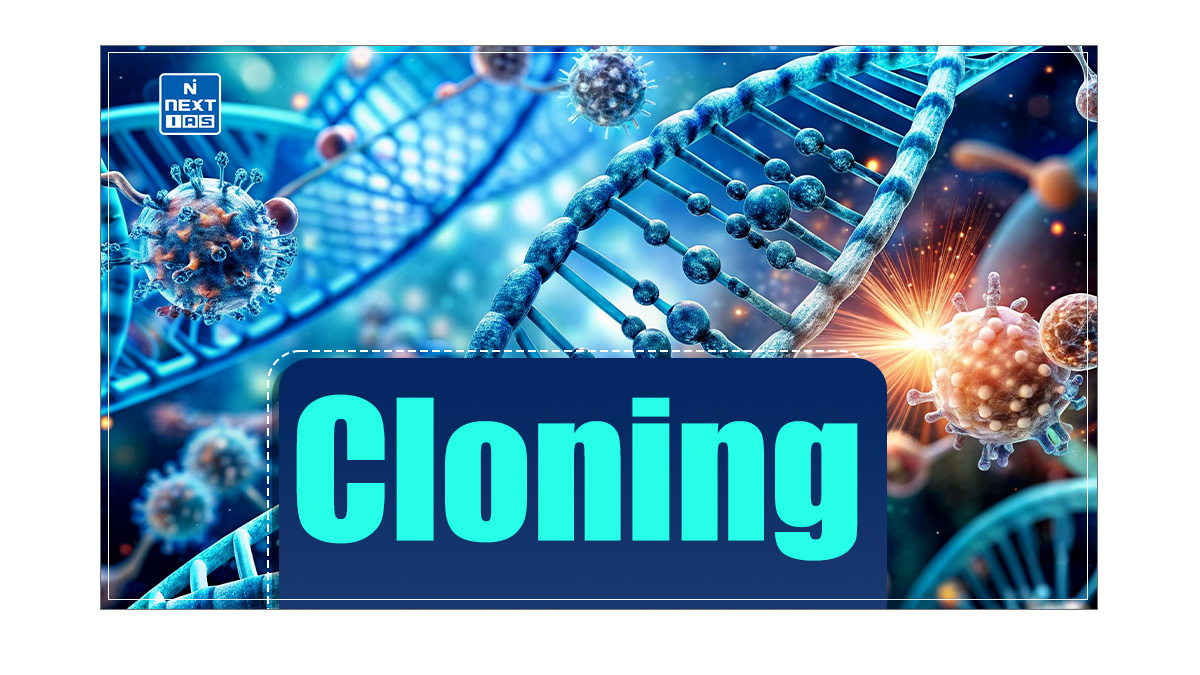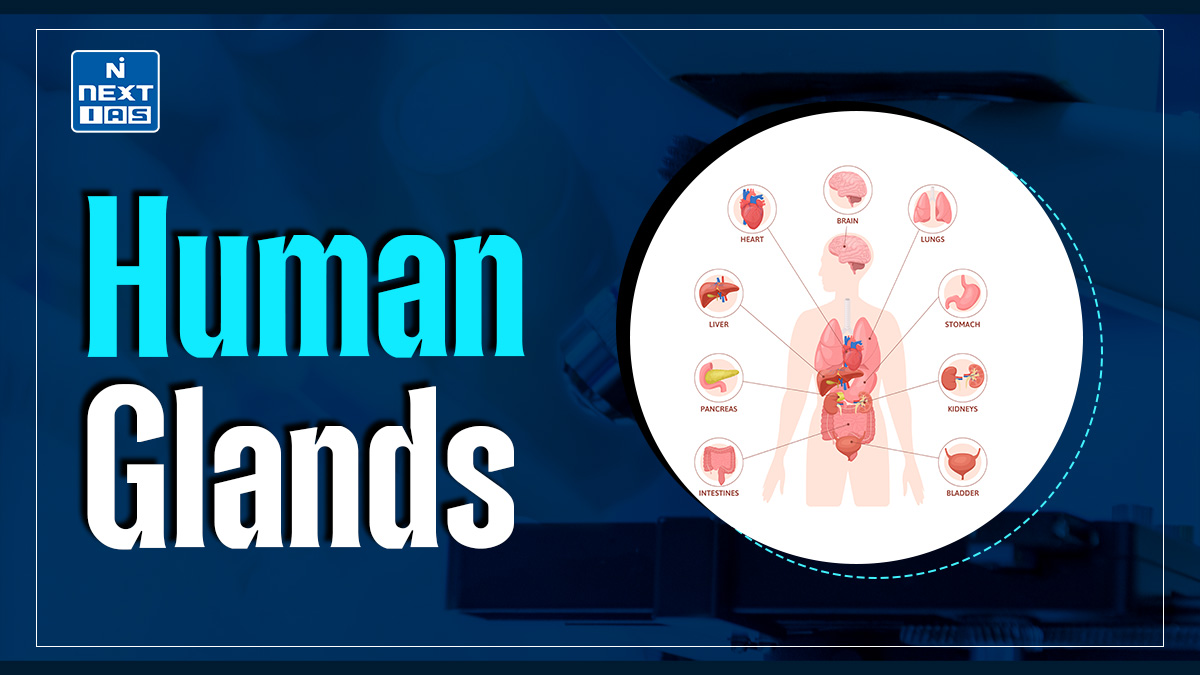
CRISPR-Cas9 is a revolutionary genome editing technology that enables precise and efficient modifications to DNA. Originating as a bacterial defense mechanism, CRISPR (Clustered Regularly Interspaced Short Palindromic Repeats) works with the Cas9 enzyme to target specific genetic sequences for editing. This article aims to provide a comprehensive overview of CRISPR-Cas9 and its working, application and future potential.
About CRISPR-Cas9
- CRISPR-Cas9 is a genome editing tool that is creating a buzz in the science world. “CRISPR” (pronounced “crisper”) stands for Clustered Regularly Interspaced Short Palindromic Repeats, which are the hallmark of a bacterial defense system that forms the basis for CRISPR-Cas9 genome editing technology.

- In the field of genome engineering, the term “CRISPR” or “CRISPR-Cas9” is often used loosely to refer to the various CRISPR-Cas9 and -CPF1, and other systems that can be programmed to target specific stretches of genetic code and to edit DNA at precise locations. With these systems, researchers can permanently modify genes in living cells and organisms and may make it possible to correct mutations at precise locations in the human genome in order to treat genetic disease.
Working of CRISPR- Cas9
- The CRISPR-Cas9 system consists of two key molecules that introduce a change into the DNA. These are: An Enzyme called Cas9. This acts as a pair of ‘molecular scissors’ that cut the two strands of DNA at a specific location in the genome so that bits of DNA can then be added or removed.
- A guide RNA (gRNA) which consists of a small piece of pre-designed RNA sequence located within a longer RNA scaffold. The scaffold part binds to DNA and the pre-designed sequence ‘guides’ Cas9 to the right part of the Genome. This makes sure that the Cas9 enzyme cuts at the right point in the Genome.
- The Guide RNA is designed to find and bind to a specific sequence in the DNA. The guide RNA has RNA bases that are complementary to those of the target DNA sequence in the genome. This means that, at least in theory, the guide RNA will only bind to the target sequence and no other regions of the genome.
- The Cas9 follows the guide RNA to the same location in the DNA sequence and makes a cut across both strands of the DNA.
- At this stage, the cell recognises that the DNA is damaged and tries to repair it.
CRISPR-Cas9 and other Genome Editing Tools
- CRISPR-Cas9 is proving to be an efficient and customizable alternative to other existing genome editing tools.
- Since the CRISPR-Cas9 system itself is capable of cutting DNA strands, CRISPRs do not need to be paired with separate cleaving enzymes as other tools do.
- They can also easily be matched with tailor-made “guide” RNA (gRNA) sequences designed to lead them to their DNA targets.
- Tens of thousands of such gRNA sequences have already been created and are available to the research community.
- CRISPR-Cas9 can also be used to target multiple genes simultaneously, which is another advantage that sets it apart from other gene-editing tools.
Applications of CRISPR-Cas9
- The most important advantage of CRISPR-Cas9 over other genome editing technologies is its simplicity and efficiency.
- CRISPR-Cas9 has a lot of potential as a tool for treating a range of medical conditions that have a genetic component, including Cancer, Hepatitis B or even High Cholesterol.
- There is a lot of potential in CRISPR-Cas9 to be used for editing germline cells as the changes made in germline cells will be passed on from one generation to another.
Limitations of CRISPR-Cas9
- Unwanted mutational events at the target locus plague standard Embryonic Stem (ES) cell based projects as well, and researchers have learned how to avoid generating mice carrying passenger mutations.
- When performing the CRISPR-Cas9 procedure directly on embryos. It is impossible to select for the desired event, greatly limiting the possibility to identify the desired allele.
Way Forward
It is likely to be many years before CRISPR-Cas9 is used routinely in humans as much research is still focusing on its use in animal models or isolated human cells, although the final aim is to use it to routinely treat diseases in Humans.
Conclusion
CRISPR-Cas9 has transformed genome editing with its precision, efficiency, and versatility, offering significant potential to treat genetic disorders like cancer and inherited diseases. Its ability to modify multiple genes and introduce heritable changes underscores its impact. However, challenges such as off-target mutations, embryonic editing risks, and ethical concerns must be addressed. While promising, further research and refinement are needed before it becomes a routine clinical tool, but CRISPR-Cas9 remains poised to revolutionize medicine and biotechnology.
Frequently Asked Questions (FAQs)
What is “CRISPR”?
CRISPR (pronounced “crisper”) stands for Clustered Regularly Interspaced Short Palindromic Repeats, a key feature of a bacterial immune system that serves as the foundation for CRISPR-Cas9 genome editing technology.
Where do CRISPRs come from?
CRISPRs were first identified in archaea (and later in bacteria) by Francisco Mojica, a scientist from the University of Alicante, Spain. He suggested that CRISPRs function as part of the bacterial immune system, protecting against viral infections. These structures contain repeating genetic sequences separated by “spacers,” which are fragments of genetic material from previous invaders. This system acts as a genetic memory, enabling the cell to recognize and eliminate returning viruses, known as bacteriophages. Mojica’s hypothesis was experimentally confirmed in 2007 by a research team led by Philippe Horvath.
How does the system work?
CRISPR “spacer” sequences are transcribed into short RNA molecules, known as CRISPR RNAs (crRNAs), which guide the system to corresponding DNA sequences. Once the target DNA is located, the Cas9 enzyme, produced by the CRISPR system, binds to it and makes a cut, disabling the gene. Researchers can also use modified versions of Cas9 to activate gene expression instead of cutting the DNA, enabling them to explore the gene’s function.
How does CRISPR-Cas9 compare to other genome editing tools?
CRISPR-Cas9 is emerging as an efficient and versatile alternative to existing genome editing tools. Unlike other methods that require separate cleaving enzymes, CRISPR-Cas9 can cut DNA strands directly. It can also be easily paired with custom-designed guide RNA (gRNA) sequences that direct it to specific DNA targets. Thousands of these gRNA sequences have already been developed and made available to researchers worldwide.
What other scientific uses might CRISPR have beyond genome editing?
CRISPR genome editing enables scientists to rapidly generate cell and animal models, advancing research on diseases like cancer and mental illness. Additionally, CRISPR is being developed for use in fast diagnostics. To promote global research efforts, Feng Zhang and his team have trained thousands of researchers in CRISPR technology and distributed over 40,000 CRISPR components to academic labs worldwide.






